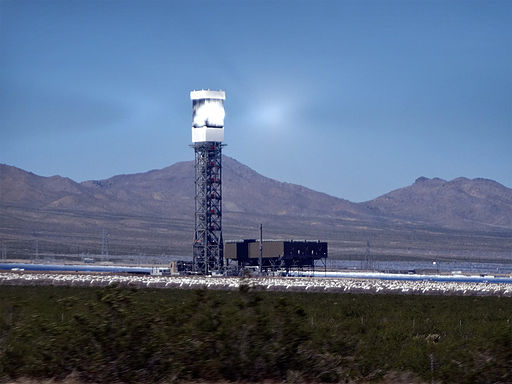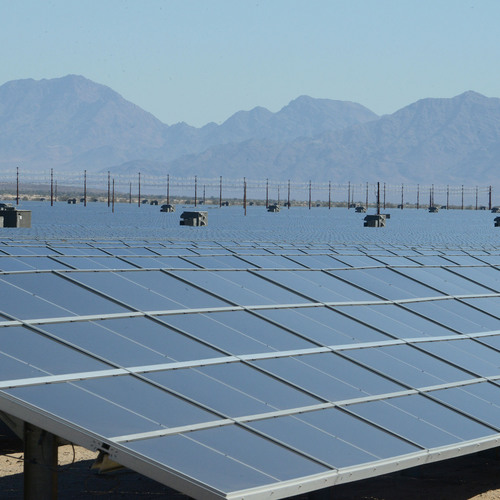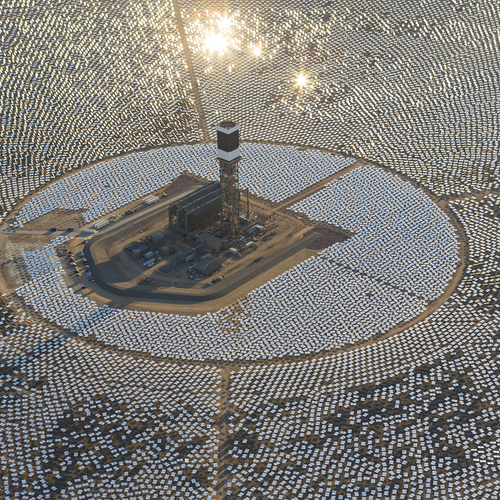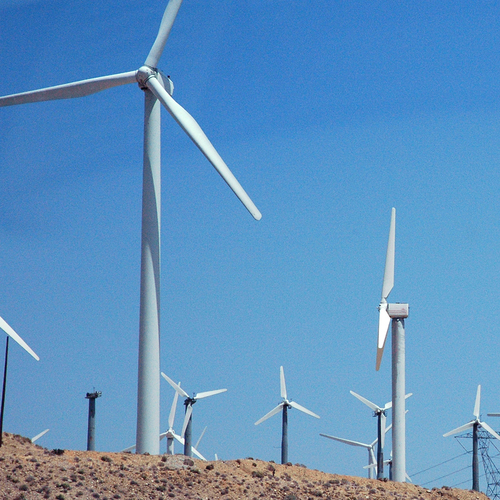
Image Credit: Wikimedia Commons
The huge Ivanpah Solar Electric Generating Station in the California desert generates electricity with thousands of mirrors that focus sunlight on towers as high as 40-story buildings. But the technological marvel, which can produce enough electricity for 140,000 homes, is apparently proving fatal to a growing number of birds, according to published reports.
News outlets that include The Wall Street Journal and the public television station KCET said dozens of birds have died around the towers, apparently as a result of flying through the 1,000-degree temperatures created by the focused sunlight.
The $2.2 billion plant, located on a five-square-mile piece of federal land near the California-Nevada border, is owned by NRG Energy, Google, and BrightSource Energy, The Journal reported. The 347,000 mirrors are arranged around towers more than 450 ft. high, each capped with a boiler. The intense sunlight produces steam, which powers generators.
Workers began finding dead birds at the project in the months before it started generating power in December. Some of them seemed to have burned feathers. They included a peregrine falcon, hawks, nighthawks, warblers and sparrows.
KCET reported the plant’s owners conducted surveys in September to look for birds. The surveys were limited to an area directly around the towers that totaled about 156 acres, less than 5% of the project’s total footprint.
The Journal quoted a NRG spokesman as saying it was too soon to draw any “definitive conclusions about long-term impacts on avian or other species.”
BrightSource had proposed a similar solar farm east of Palm Springs, but California’s Energy Commission suggested the company use different technology, such as solar panels.
Wind farms have had their own problems with bird and bat fatalities. Biologists estimate that wind farms have killed dozens of bald and golden eagles as well as 600,000 bats.
Weekly Newsletter
Get building science and energy efficiency advice, plus special offers, in your inbox.















5 Comments
It's all relative
I know this gets mentioned a lot when renewables correlated to animal fatalities, but we should think about how many animal (and human) deaths are related to other energy sources/daily activities.
Just food for thought, as i do not have hard numbers. (just a few examples)
- How many animals/humans die as a result of mountaintop removal coal mining? (both from the mine, and it's toxic byproducts)
- How many animals/humans die as a result of coal fired power plant emissions?
- How many animals die as a result of filling a reservoir for a hydro dam?
- How many animals die as a result of hydraulic fracturing for natural gas and oil?
- How many animals die as a result of off-shore oil drilling?
- How many animals/humans die as a result of driving your car everyday?
- How many animals/humans die as a result of logging for the lumber that makes up our homes?
- How many birds die as a result of running into glass windows on a home or commercial building?
- How many animals die as a result of mining the raw materials for solar PV panels?
- and let's not get into eating meat ;)
I'm not saying we should stop all these activities (maybe some of them....) but just think about how everything we do impacts our environment in some way. It's not surprising that a power plant will result in the deaths of some animals, but the question to me is: How many deaths, compared to how much energy is produced?
[Scott, I'm not accusing the article (or you) of saying solar is bad for killing birds, but just mentioning something that people can consider before either commenting in a Negative/Positive way on the news article]
Response to Daniel Young
Daniel,
Thanks for your comments. You have provided an important perspective.
Mortality per terawatt hour figures
Ivanpah's annual output is estimated to be just over one terawatt hour. There isn't sufficient data yet to accurately estimate the avian mortality per terawatt-hour just yet, to be able to compare it to other power generators. It's also not easy to come up with good bird mortality figures related to rooftop PV, but utility-scale PV still has to look at the ground-level habitat disruption issues carefully, not just bird electrocutions, etc., so whether dedicating the Ivanpah real-estate to equivalent output PV is a net benefit or harm is an open question.
The US average avian deaths per Twh break down as roughly:
wind: 270
nukes: 600
fossil- (all fuels): 9400 (primary attribution is from climate disruption) so this is a fuzzy number)
(Source= http://papers.ssrn.com/sol3/Delivery.cfm/SSRN_ID2198024_code1250463.pdf?abstractid=2198024&mirid=1 )
So, while a couple dozen fried birds per month might be of some concern, 24 birds/month would be about 300 birds/Twh, which is on the same order of magnitude as wind power & nukes, but an order of magnitude below that of fossil-fired power.
According to Dutch researchers direct bird mortality from windmill collision have a fixed annual deaths per turbine, and not sensitive to the size of the turbine- a 100kwh pipsqueak kills about as many birds as a 10MW behemoth, despite the much larger swept area and size, and 100x output of the larger windmill. So as wind turbines become larger, the avian deaths/Twh is going down. But the largese impacts on bird populations for wind farms (an any other construction) is from siting: Disturbing nesting area to build a wind farm or a coal mine is much more damaging to the bird populations than the operation of the power plant.
House-pet sized felines (feral or pets) kill more than an order of magnitude more birds than wind farm in the US, and collisions with buildings kill two orders of magnitude more birds than wind farms. Even if 100% of the power in the US was sourced by wind farms, it would still not quite reach the bird mortality imposed by the presence of buildings.
Bird mortality is one thing, human mortality another.
Wind farms (construction & operation) result in about 0.15 human deaths per terawatt hours, 15 deaths per terawatt hour from thermal coal (US only- the world wide average over 150) , a 100-fold difference. The US coal- power mortality is primarily the early mortality consequences of the emissions, but also from mining & construction. Rooftop solar PV kills about 0.44 humans/Twh primarily from installers falling off roofs,. but also electrocution.
Some popular press grist for that mill lives here:
http://mediamatters.org/blog/2013/03/27/forbes-reaches-to-find-wind-power-fatalities/193299
Research and clarification in technology
I am not sure why it appears that the thermal energy solar tower is called "Solar Thermal Plant". First there is other power plants that are working and are a different technologies in the Solar thermal industry. It should be specified when reporting. One that comes to mind is parabolic trough, that is different then the power tower, but is still a Solar Thermal Plant. Please continue to review the solar/alternative energy industry successes and continue to do more research in this area. Please be more clear and detailed for readers, so that everyone has a little more information. Thank you.
Response to Sophia Padilla
Sophia,
The Ivanpah Solar Electric Generating Station is, indeed, a solar thermal generating plant that uses heat to drive steam turbines. The article accurately describes the plant as one that "generates electricity with thousands of mirrors that focus sunlight on towers." It differs from a solar thermal plant that uses parabolic trough collectors, but we did not confuse the two technologies.
Log in or create an account to post a comment.
Sign up Log in